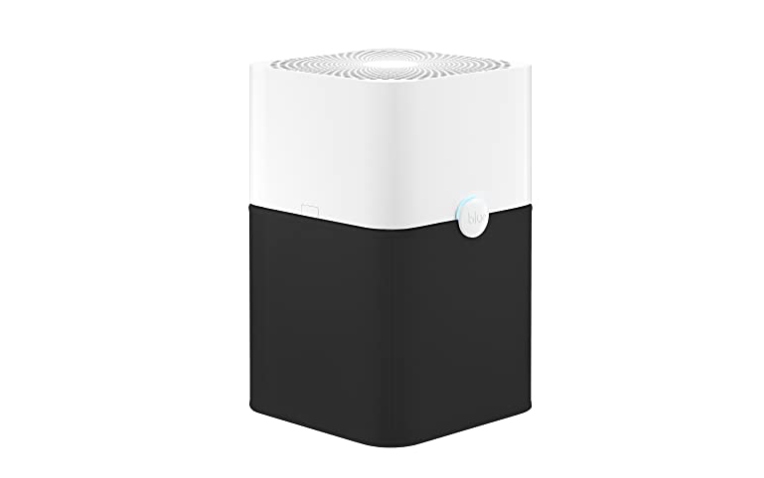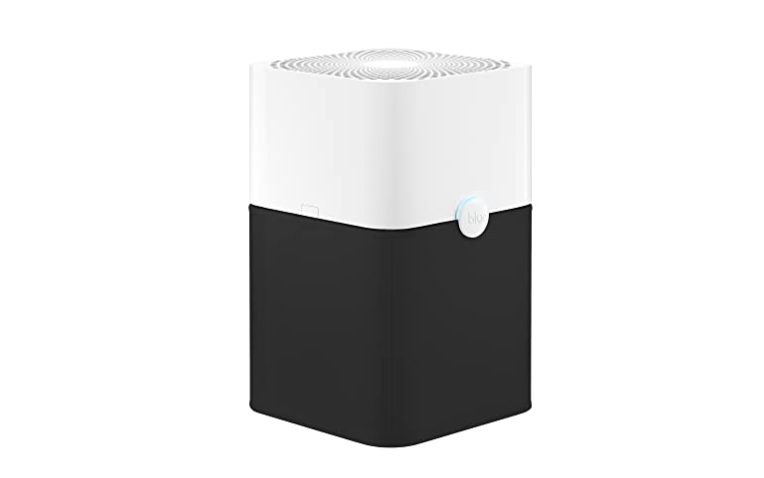blue air pure 211+ fan noise level and other features make this air purifier one good option for medium to large-sized rooms, certified by AHAM. This article is mainly a blue pure 211+ air purifier review that will include an in-depth review of the product including pros and cons as well. So, let’s get started.
Product Review for Blue air pure 211+ fan noise and other features

Product Specifications of Blue air 211+ air purifier
| Specifications | Blueair pure 211 |
| Dimensions | 13 x 13 x 20.4 inches |
| Weight | 13 lbs. |
| Filters | Swedish filter technology |
| Air purifier operations | Single-button operations |
| Coverage | 540 sq. ft² |
| CADR | 350 cfm |
| Fan speed | 3 |
Detailed blue pure 211+ air purifier review
1. Filters
The Blueair blue pure 211+ 3-stage air purifier does not have HEPA air filters. It uses carbon filters and a combination of particles to remove dust, pollens, chemicals, and gases by around 99%. The blue air filter is classified as a pre-filter and gas filter.
Pre-filters
The pre-filter on the Blue Pure 211+ is one of a kind. The pre-filter is a washable colored fabric that wraps around the bottom part of the air purifier like a sock. The metal grille that intakes air from all four sides of the air purifier blueair is covered by the pre-filter.
Most other air purifiers on the market, especially those in the same price range, have a pre-filter as well. However, in most other systems, the pre-filter is installed after the intake grille, not before it.
There isn’t much of a difference in terms of filtering quality. The pre-job filter is to keep the primary particle filter (which is a proprietary particle filter in the 211+) clean by filtering out bigger particles (typically larger than 1 micron in diameter).
Gas filters
A carbon filter is included with the Blueair Blue Pure 211+ to help with gas filtration (removal of unwanted gases like odors and VOCs). In the air purifier sector, carbon is the gold standard for gas filtration.
Most air purifiers on the market, including the aforementioned Coway Airmega and Mighty, the Winix 5500-2, and most others, come with carbon filters for gas filtering.
The distinction between them is in how and to what extent they use carbon filtration. Carbon filters are used in some units, and they consist of a fibrous substance that has been coated with carbon. Other models contain carbon filters that are made up of a plastic frame that holds genuine carbon pellets.
2. Performance
When it was tested, the blue air purifier 211 tied for first place with three other models by the company. It’s a smidgeon better than the other top-performing models, but not by enough to merit a higher rating. It lowers the airborne particle levels by 98.97 percent after a half-hour of fighting the haze in our smoke in the room, and it improved to 99.95 percent just 15 minutes later. It stayed at that level for the whole of our hour-long test.
It also has the greatest CADR (clean air delivery rate) of all the models we evaluated, at 350, allowing it to handle rooms up to 525 square feet.
3. Coverage and airflow
When it comes to coverage, blue air blue pure 211 is not recommended for the space larger than 300 sq. ft., despite its 360 CFM total output. Most consumer periodicals claim that the unit can clean the air in rooms up to 400, if not 500 square feet. This is because when it was tested in the larger spaces, it alone was not able to provide full coverage to the room sizes greater than 300 square feet. In one place, a single air purifier has one inlet (to take in unclean air) and one outlet (to distribute clean air). This becomes a problem at 300 square feet.)
4. Blue air pure 211+ fan noise Level
When the Blue air pure 211+ fan noise level was tested, it proved to be a high-end end air purifier too. To test it, it was set to high speed, and it sounds a lot like the Coway, offering a medium pitch that’s detectable yet constant and mellow enough to fade into the background once you’ve become used to it. It makes a very mild hum on low, which you may detect while doing peaceful activities like reading, but which is in no way bothersome. On low, the Coway is a little better in this sense, as it is almost silent.
On its highest fan speed, the Blue Pure 211+ fared admirably in our noise output test. It was measured at 66.7 decibels on high. On the same setting, the Coway Mighty, AirMega, and Winix 5500-2 all had measured noise outputs of 66 to 68 dB. (high fan speed).
The primary problem with the 211+ in terms of noise output is that it lacks a super low fan speed setting where it barely makes any noise. It produces a significant amount of noise even at its lowest fan speed, with a measured noise output of 47.2 dB.
On lower settings, comparable units performed far better. The Coway Mighty, AirMega, and Winix 5500-2 all produced a controlled amount of noise.
5. Durability
The 211+ is a well-constructed appliance. The materials utilized to build it are of exceptional quality. When comparing the blue air purifier 211 +to other air purifiers on the market, there are few that appear to be of superior quality than the Blue Pure 211+.
The 211+ also has a great guarantee – five years provided you register your purchase with the manufacturer.
6. Value as per Blueair blue pure 211 review
The blueair 211 is a bad investment. Because of its substantially above average 360 CFM, it retails for the price it does. However, as previously said, for around the same money, you can get two top-rated 250 CFM units for a total of 500 CFM. As a result, the one major reason you’d want to spend extra on the 211+ (high CFM) is moot.
The equipment is fairly energy efficient, and the filters are reasonably priced — a replacement filter costs around $50. The filter, on the other hand, is a particle and gas filter in one. When only one of the filter’s components – the particle or gas filter component – saturates, you must replace the entire filter.
7. User-friendliness
In our ease of use tests, the Blueair 211 received an average rating. It’s easy to use, with only one button to switch it on and off, as well as cycle through three fan settings. Considering how strong it is, the weight is rather light at 12.2 pounds, making it easy to maneuver. We docked points for its lack of features; a machine of this level should have additional fan speeds and, at the very least, an automatic off-timer.
What are the Pros of blue air purifier 211
The positive sides of blue air purifier 211 include
- Blue air purifier 211+ has a high CFM speed with a low noise output
- It has the ability to intake the air at 360 degrees
- This unit is energy efficient with a great build
- It has a three-stage filtration system
- Comes with five years of warranty.
What are the Cons of blue air blue pure 211
The downsides of blue air purifier 211 are
- It does not offer many fan speeds
- blue air blue pure 211 has shown that It lacks smart features like remote control or timer
- Although it is a three-stage air purifier it does not have a HEPA filter.
What is the recommended room size of blue air blue pure 211+?
The number of units for a large room is determined by the coverage of an air purifier. However, according to our opinion, instead of having a single unit with high cfm, it is better to have 2 units. For instance, the best option to have is 250 cfm units which provide a cfm of 500.
